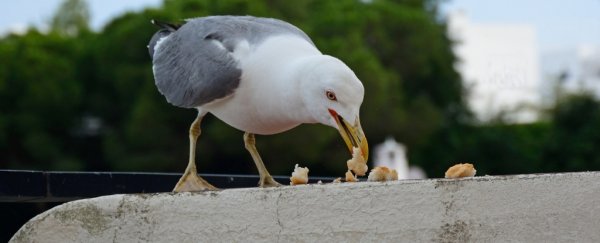They've been watching us for decades. Monitoring our movements. Studying our behaviour. Tracking our routines. Stealing our chips.
In the seaside city of Bristol gulls are the ultimate human stalkers, and the timing of their peck is impeccable.
Scientists tracking these birds have discovered gulls are so well adapted to human urban environments, they know exactly where to forage for food, and more importantly, when.
In one of the United Kingdom's most gull-infested cities, these shrewd birds have figured out when a local school takes its breaks, and they've shifted their own meal times accordingly.
Just before the midmorning and mid afternoon recess, when students begin to unpack their goodies in the school yard, gulls of all sorts can be spotted on the surrounding rooftops, sitting and waiting for the kids to come.
Scientists counted the highest number of birds at 11:15 am and 12:45 pm, which is also when the schoolyard was most crowded with children. The school breaks fell between 11-11:20 am and 12:20–13:00 pm.
"Our first day at the school, the students were excited to tell us about the gulls visiting their school at lunch time," says Anouk Spelt, who studies the behaviour of urban nesting gulls at the University of Bristol.
"Indeed, our data showed that gulls were not only present in high numbers during lunch time to feed on leftovers, but also just before the start of the school and during the first break when students had their snack."
Despite their apparent ubiquity in cities worldwide, remarkably little is known about the behaviour of urban gulls. In the park or in a school yard, one of these birds likely has an eye on you, and if you're sitting down for a meal, there's probably more than a few.
Most of us know these birds as pesky, opportunistic and bold scavengers, digging through piles of rubbish, snatching at food in our hands and flying away with our scraps. But while we know how they impact us, comparatively little is known about how we impact them.
Previous studies have shown gulls exploit numerous human food sources, including food waste and fishery discards, but it's not yet clear how the timing or location of these scraps influences bird behaviour.
The ability to predict when human food will become available could be one reason why these scavengers have come to thrive in cities worldwide, even as numbers in the wild decline.
In the summer of 2018, researchers set up a dozen lesser black-backed gulls (Larus fuscus) with GPS devices and tracked their movements for a month, focusing on three feeding grounds close to their nests: a park, a school and a waste centre.
The team also counted how many gulls were present at each location. Every 15 minutes for seven weekdays, the number of herring gulls (L. argentatus), black-headed gulls (Chroicocephalus ridibundus) and black-backed gulls were tallied at each location, as well as the number of people around and the availability of food.
"At both the school and the waste centre, gulls were observed waiting on the surrounding rooftops before school breaks and before waste was unloaded, implying that they were waiting there specifically for food to become available," the authors write.
"The temporal predictability of the food sources at these sites appears to have resulted in the birds adopting a sit‐and‐wait approach instead of actively searching for food."
The findings are supported by a study conducted all the way back in 1983, which found more gulls at a local refuse tip when waste was being unloaded.
This suggests gulls can predict when human food sources will become available, allowing them to conserve energy required from active foraging, while also adapting to the sprawl of human cities and a lack of wild habitats.
Over the weekend, when the school and dump were closed, the gulls with GPS trackers did not visit the three feeding grounds nearly as frequently.
Foraging in the park, on the other hand, appeared to have less to do with human activity and more to do with natural resources. In the early morning, gulls in the study usually flew to the park, where they were seen pecking at the ground.
"Although everybody has experienced or seen gulls stealing food from people in parks, our gulls mainly went to park first thing in the morning," says Spelt, "and this may be because earthworms and insects are present in higher numbers during these early hours."
One particularly interesting discovery was the staggered timing of all three food sources - the park, the school and the dump - which raises the possibility that some gulls are travelling from one resource to the next, timing their foraging with several human schedules at once.
Still, this isn't the first time gulls have taken cues from human behaviour. A 2019 study found hungry gulls can be chased away from a picnic table with intense eye contact, and a recent follow-up by the same team found these birds prefer to eat food already handled by humans.
Modelling their behaviour on human routines might be part of their success in cities, although other factors may contribute, including more comfortable temperatures, fewer predators and plenty of nesting sites.
Plus, while some gulls might be thriving in human cities, those same urbanised birds account for only a small proportion of the total species population. Most gulls are still found in the wild, where they are struggling to survive due to, among other things, overfishing, pollution and habitat loss.
In the past thirty years, some researchers estimate non-urban herring gull numbers have dropped by 60 percent, and lesser black backed gulls have declined by more than 30 percent.
One day, our cities may be the only place for gulls to survive. No wonder they're trying to adapt.
The study was published in Ibis.
